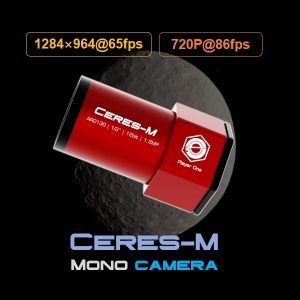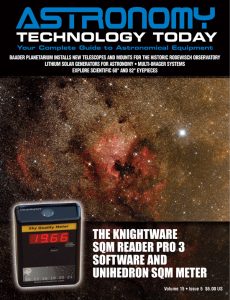The Player One Ceres Planetary Cameras are the latest release by the Suzhou, China based company and include the Ceres M (mono) and Ceres C (color).
The Ceres-C is a guiding camera which adopts the Sony IMX224/225 1/3” format sensor. The 3.75um pixel size accommodates a well depth of 19.4ke with a total of 1.2MP (the resolution is 1304*976), and the diagonal is 6mm.
The Ceres-M is a guiding camera which utilizes the Aptina AR0130 1/3” format sensor. The 3.75um pixel size accommodates a well depth of 18ke with a total of 1.2MP (the resolution is 1280*960), and the diagonal is 6mm.
Both cameras offer an integrated USB3.0 data port(500Mb/s), which can provide over 10 times higher speed than a USB2.0 device(60Mb/s). When the Ceres-M is connected to the USB3.0 interface and full-resolution preview is used, it can reach 65 FPS in RAW8 mode (10bit ADC). When Ceres-C is connected to the USB3.0 interface and full-resolution preview is used, it can reach 154 FPS in RAW8 mode (10bit ADC).
 Ceres- M specifications include:
Ceres- M specifications include:
– Sensor: Aptina AR0130 CMOS (Mono)
– Diagonal: 6mm
– Total Pixels: 1.2 Mega Pixels
– Max Resolution: 1284×964
– Pixel Size: 3.75μm
– Chip Size: 4.8×3.6mm
– Frame Rate: 65FPS(10bit)
– Shutter: Rolling shutter
– Exposure Range: 32μs-2000s
– Readout Noise: 7.3e – 3.6e
– QE Peak: ≈80%
– Full Well: 18k e
– ADC: 12 bit
– Data Port: USB3.0/USB2.0
– Adapter: 1.25″ / M28.5X0.6
– Back Focal Length: 7.5mm
– Protective Window: AR coating
– Diameter: 40mm
– Weight: 65g
 Ceres- C specifications include:
Ceres- C specifications include:
– Sensor: Sony IMX224/225 CMOS (Color)
– Diagonal: 6mm
– Total Pixels: 1.2 Mega Pixels
– Max Resolution: 1304×976
– Pixel Size: 3.75μm
– Chip Size: 4.9×3.7mm
– Frame Rate: 154FP (10bit)
– Shutter: Rolling shutter
– Exposure Range: 32μs-2000s
– Readout Noise: 3.0e – 0.74e
– QE Peak: About 80%
– Full Well: 19.4k e
– ADC: 12 bit
– Data Port:USB3.0/USB2.0
– Adapter: 1.25″ / M28.5X0.6
– Back Focal Length: 7.5mm
– Protective Window: AR coating
– Diameter: 40mm
– Weight: 65g
You can learn more about the Player One planetary cameras here.
 And to make it easier for you to get the most extensive news, articles and reviews that are only available in the magazine pages of Astronomy Technology Today, we are offering a 1 year subscription for only $6! Or, for an even better deal, we are offering 2 years for only $9. Click here to get these deals which only will be available for a very limited time. You can also check out a free sample issue here.
And to make it easier for you to get the most extensive news, articles and reviews that are only available in the magazine pages of Astronomy Technology Today, we are offering a 1 year subscription for only $6! Or, for an even better deal, we are offering 2 years for only $9. Click here to get these deals which only will be available for a very limited time. You can also check out a free sample issue here.

